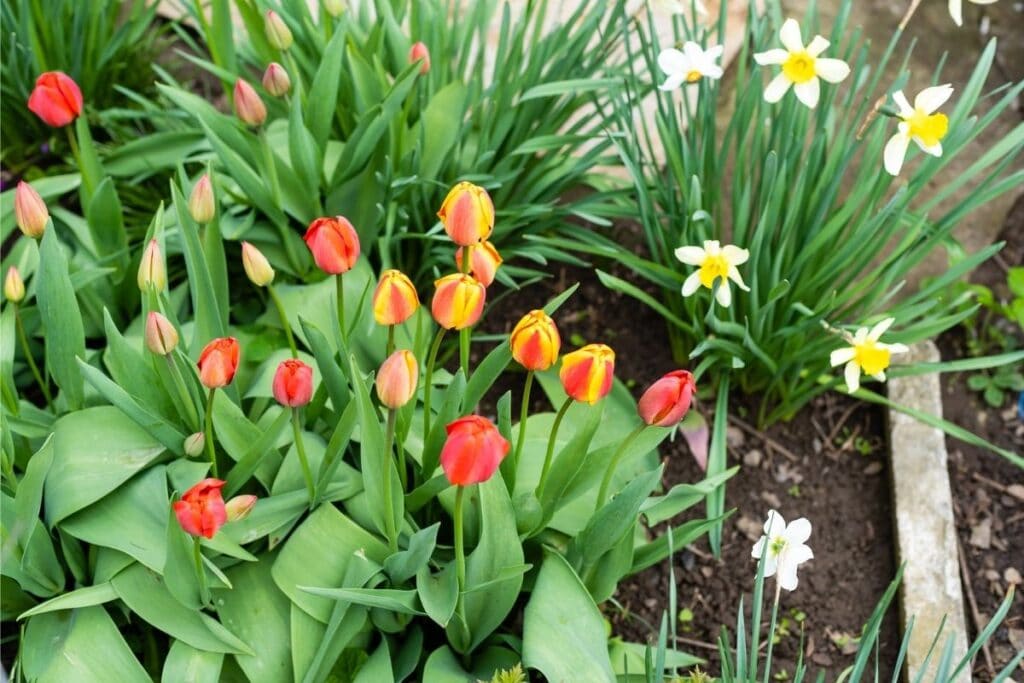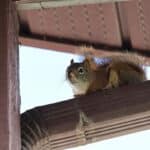For many gardeners, keeping grass out of the garden beds is a struggle. If you’re not careful, those pesky blades of grass can quickly take over your garden bed and dominate your plants.
But with a few simple tips, you can keep that grass at bay and have a beautiful garden to show for it.
Read on to learn more about how to keep grass out of your vegetable and flower garden beds!
Preventing Grass in a Flower Bed
We all know that unwanted grass can quickly take over a flower bed. But there are a few simple steps you can take to prevent grass from getting the upper hand.
First, make sure to choose a site for your garden bed that gets plenty of sun. Grass needs sunlight to grow, so a sunny spot will make it more difficult for grass to take hold. Second, don’t forget to add a thick layer of mulch to your garden bed. This will help to suppress weed growth and further deter the spread of grass.
Finally, be sure to remove grass that does manage to sneak into your bed as quickly as possible. By staying on top of things, you can keep your garden looking its best.
How to Keep Weeds Out of Flower Beds
If you’re like many people, you love spending time in your garden, but sometimes the grass can be a nuisance. Here are a few tips to help keep the grass from growing in your garden beds.
Know the Best Time to Kill Grass in Flower Beds
There is no one definitive answer to the question of when the best time to kill grass in a garden bed is. Some people believe that killing grass during the spring or summer months is best, as this allows you plenty of time to plant and establish new plant life before winter sets in.
Ultimately, the key is to carefully plan your kills so that they do not disrupt your existing plant life too much and so that they give your new plants enough time to get established before they face their first frost. Whichever season you choose, just be sure to take the time to carefully plan out your kills so that you can have a successful garden year after year.
Use a Selective Herbicide
A selective herbicide is a type of weed killer that targets specific plants. This can be incredibly helpful when you’re trying to kill grass in garden beds without damaging other native plants. Selective herbicides are typically applied with a pump sprayer, and they work by being absorbed through the leaves and then translocating to the roots.
This means that it’s important to completely cover the leaves of the target plant in order to achieve effective control. There are a few different active ingredients used in selective herbicides, so be sure to read the label carefully to choose one that will be effective against the type of grass you’re trying to kill.
With a little bit of care, you can use a selective herbicide to kill grass in raised garden beds without harming other plants.
Use Pre-Emergent Weed Killers
When it comes to controlling weeds in garden beds, pre-emergent weed killers can be a great solution. These products work by interfering with the germination process of weed seeds, preventing them from sprouting and growing.
By using this type of product along the edges of your garden beds, you can effectively eliminate unsightly grasses without harming any desirable plants.
Additionally, as these products typically only affect certain types of weed seeds, they are less likely to cause any unintended damage to nearby native foliage or flowers.
Ultimately, if you are looking for a quick and easy way to get your garden beds looking their best, then pre-emergent weed killers may be just what you need.
Try Vinegar
One common use for vinegar is as a natural weed killer, and this can be especially useful in garden beds where grass tends to grow.
When sprayed on grass, vinegar kills the roots quickly and prevents new growth from sprouting up. In addition, vinegar works by changing the pH levels in the soil, making it difficult for other weedy plants to thrive as well. Just don’t get it on the plants you’re actually trying to grow!
If you’re looking for an easy way to get rid of unwanted grass in your vegetable beds, consider trying vinegar instead of more traditional chemical weed killers. With consistent application and proper care, you’ll be able to keep your garden beds looking beautiful and weed-free all season long!
Use Boiling Water
When it comes to killing unwanted weeds in garden beds, most gardeners know that boiling water is one of the most effective methods. This is because hot water can quickly penetrate and damage grasses at their roots, ultimately causing them to die off.
To use boiling water effectively, simply pour a pot full into the center of any unwanted grasses on your garden bed. As long as you thoroughly drench the area with this hot liquid, you should soon see your grass starting to wilt and eventually turn brown and die off completely.
Set the Grass on Fire (Seriously!)
One way to kill bermuda grass and prevent it from growing back is to set it on fire. This may sound dangerous, but if you take the proper precautions, it is actually quite safe. And best of all, it is an effective way to eliminate unwanted grass in your garden beds.
To get started, clear the area of any debris that could catch fire. Then, use a metal rake to create a barrier between the grass and the rest of the bed.
Next, light a small fire in the center of the area and allow it to spread outward. The heat will kill the grassroots and scorch the blades of grass, making it impossible for new growth to occur. Finally, extinguish the fire and allow the area to cool before replanting.
Solarization
Solarization is one of the most effective strategies for removing unwanted grass, as it uses heat to desiccate and effectively burn away the plant tissue. This process works by placing clear or dark-colored plastic over the bed and using the sun’s warming rays to accelerate evaporation and increase soil temperatures.
By doing this, solarization kills the grasses from the roots up, and ensures that they don’t come back once you remove the plastic.
Use Corn Gluten
Corn gluten meal is a natural by-product of the milling of corn and it contains high levels of nitrogen. When applied to your garden beds, it will prevent weed seeds from germinating. It’s also safe to use around children and pets. Best of all, it’s inexpensive and easy to find at most garden supply stores.
Pull Grass By Hand
It’s important to remove weeds, including bermuda grass, from the garden on a regular basis. One way to do this is to pull them by hand. While this may seem like a tedious task, it’s actually an effective way to control grass growing. Hand-pulling ensures that the entire weed is removed, root and all.
This prevents them from regrowing and spreading seeds. In addition, it’s a relatively low-impact method that doesn’t require the use of chemicals or other harsh agents. So next time you see a weed in your garden bed, consider pulling it by hand. It just might be the best solution for your garden.
Use Mulch
Adding a layer of mulch to your garden beds is one of the simplest and most effective ways to improve the health of your plants. Mulch helps to regulate soil temperature, keeping roots cool in summer and warm in winter.
It also helps to prevent moisture loss, reduces the need for watering, and protects against extreme weather conditions. In addition, mulch suppresses weed growth, adding an extra layer of protection for your plants.
There are many different types of mulch available, so it’s important to choose one that is right for your particular garden.
For example, organic mulches such as bark or straw break down over time, adding valuable nutrients to the soil. Inorganic mulches such as gravel or stone do not break down, but they can help to improve drainage and prevent waterlogging. Whichever type of mulch you choose, be sure to apply it thickly enough to be effective. A depth of 2-3 inches is usually recommended.
Sow Seed Outside of the Beds
Be sure to give yourself a wide perimeter around your garden beds when sowing grass seed. This will give the grass plenty of room to spread out and fill in any gaps that might otherwise be invaded by weeds without having to worry about it creeping into the beds.
Use a String Trimmer
A string trimmer is a tool that uses a spinning wire to cut through grass and other vegetation. It can be used to trim grass around flower beds, walkways, and other landscape features. String trimmers are available in different shapes and sizes, and they can be powered either by gasoline or electricity.
A string trimmer can be a useful tool for keeping your flower beds neat and tidy and for keeping grass out of the garden!
Work on Your Edging
Edging serves several key purposes in the garden, including physically separating different planting areas and keeping plant materials neatly contained within the borders of the bed. What’s more, edging is also an effective way to keep grass from creeping into the garden beds.
Landscape Fabric?
Some people believe that using this material can prevent soil erosion and provide benefits like improved drainage and weed suppression. It can be helpful at keeping grass out of the garden beds, especially in the short term.
However, others maintain that landscape fabric actually has negative effects on the soil, interfering with its natural processes and leading to higher water retention, which can be especially problematic in warmer climates. Not only that, but over time, landscape fabric can deteriorate and grass blades will be able to poke through. They’ll be harder to pull by hand since they’ll be rooted into the fabric.
Think carefully about whether the short-term benefits of landscape fabric are worth it before you choose to install it in your garden beds.
Be Careful With Mulch Hay
Hay is often used as mulch in garden beds, and while there are some benefits to this practice, there are also a number of potential drawbacks. For one thing, hay contains loose grass seeds that can easily sprout once the hay has decomposed. This can lead to an unwanted invasion of most weeds that can be difficult to remove from the garden.
Additionally, because hay tends to be left in its natural state rather than being composted or otherwise broken down, it takes a long time to decompose.
This can create uneven growth patterns in the garden bed, leading to inconstant moisture levels throughout the soil. For these reasons, while hay may seem like an attractive option for mulching garden beds, it is best to consider alternative materials such as wood chips or straw instead.
How Do I Kill Grass Naturally?
There are a number of different methods that you can use to kill grass naturally, depending on the type of grass you’re dealing with and the conditions that exist in your particular area. Some common options include applying herbicides, smothering the grass by placing mulch or stones over it, or using boiling water to gradually kill the roots.
Other techniques involve changing the pH level in your soil or introducing more shade to slow down plant growth.
While none of these methods are guaranteed to be 100% effective, choosing the right one for your situation can help you get rid of unwanted weeds and pave the way for more desirable plants and flowers. So if you’re looking to clear out some unwanted turf, do your research and try out a few different methods to find the one that works best for you!
FAQs
How do you edge grass around a flower bed?
To edge grass around a flower bed, you can use a manual or mechanical edging tool to create a clean separation between the grass and the flower bed. Simply run the edging tool along the edge of the flower bed, cutting through the grass roots to create a defined edge.
How do I kill grass around my rose bushes?
To kill grass around your rose bushes, you can use several methods. One option is to carefully apply a non-selective herbicide, such as glyphosate, to the grass while avoiding contact with the rose bushes. Alternatively, you can smother the grass by covering the area with layers of cardboard or thick mulch, depriving it of sunlight and air.
What can I use instead of garden edging?
Use trench edging, landscape timbers, recycled materials, or plants as alternatives to traditional garden edging.
If you’re having trouble keeping the grass from invading your garden, try these tips. We’ve outlined some of the most effective methods for preventing grass from growing in your garden so you can enjoy a weed-free space. Have you tried any of these techniques?
See more: How to keep weeds out of vegetable garden
*image by sinenkiy/depositphotos







